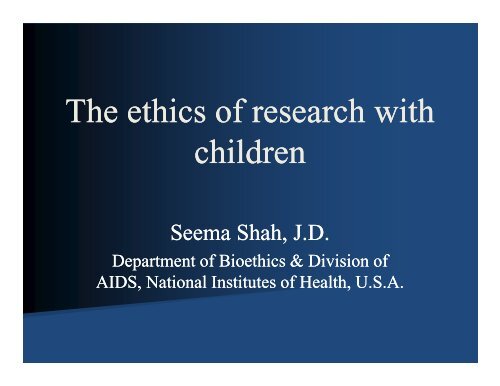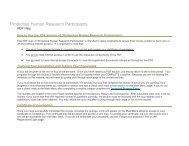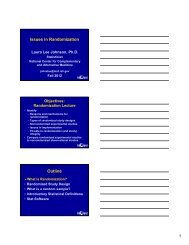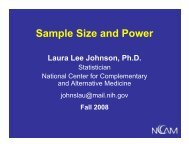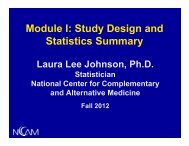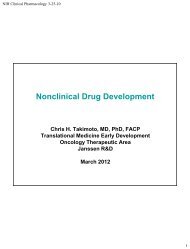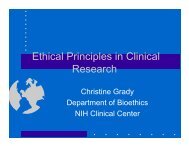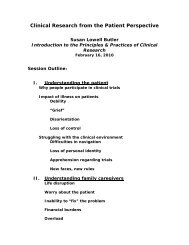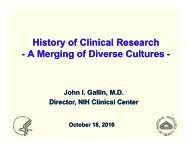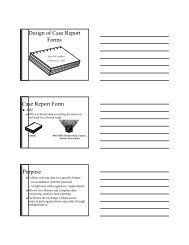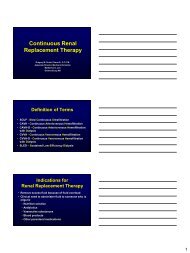The ethics of research with The ethics of research with children
The ethics of research with The ethics of research with children
The ethics of research with The ethics of research with children
Create successful ePaper yourself
Turn your PDF publications into a flip-book with our unique Google optimized e-Paper software.
<strong>The</strong> <strong>ethics</strong> <strong>of</strong> <strong>research</strong> <strong>with</strong><br />
<strong>children</strong><br />
Seema Shah, J.D.<br />
Department <strong>of</strong> Bio<strong>ethics</strong> & Division <strong>of</strong><br />
AIDS, National Institutes <strong>of</strong> Health, U.S.A.
Disclaimer<br />
• <strong>The</strong> opinions expressed are the author’sown<br />
own.<br />
<strong>The</strong>y do not reflect any position or policy <strong>of</strong><br />
any U.S. governmental entity, including the<br />
National Institutes <strong>of</strong> Health.
Case study<br />
• Researchers wanted to learn how and why the<br />
brains <strong>of</strong> <strong>children</strong> <strong>with</strong> attention deficit<br />
hyperactivity disorder (ADHD) do not develop<br />
normally.<br />
• Planned to use a device that uses magnetic<br />
fields to stimulate nerve cells in the brain.<br />
• Device hd had not been tested di in <strong>children</strong> before.<br />
bf
Case study<br />
• <strong>The</strong> device also made a loud noise (110<br />
decibels even if the kids wore earplugs and<br />
headphones).<br />
• In ordinary life, people are exposed to louder<br />
noises when:<br />
– Mowing the lawn<br />
– Going to a loud rock concert<br />
– Listening to loud music on an iPod
Case study<br />
• <strong>The</strong> <strong>research</strong>ers asked for an <strong>ethics</strong><br />
consult and wanted to know:<br />
– Is it ethical to expose kids <strong>with</strong> ADHD to<br />
this risk <strong>of</strong> harm<br />
– Is it ethical to expose healthy kids to this<br />
risk <strong>of</strong> harm
Need for pediatric <strong>research</strong><br />
• Tremendous need to find the right treatments<br />
and dosages for <strong>children</strong>, given that <strong>children</strong><br />
are not small adults.<br />
* It has been estimated t that t 75% <strong>of</strong> drugs prescribed<br />
to <strong>children</strong> have not been tested in <strong>children</strong>, even<br />
for basic safety and efficacy.
Problem<br />
• If you were a parent <strong>with</strong> a sick child, you<br />
would want good evidence for the medical<br />
care your child receives.<br />
• But, you probably bl do not want your child to be<br />
exposed to risk in <strong>research</strong> for the benefit <strong>of</strong><br />
other <strong>children</strong>.
How do we address this problem<br />
• First, protect <strong>children</strong> from harm:<br />
– Regulations and guidelines provide acceptable risk/benefit<br />
ratios for <strong>research</strong> & limits on acceptable risk.<br />
• Second, respect people’s ability to make<br />
choices that fit <strong>with</strong> their values and interests:<br />
– Focus on parental consent/permission and child assent.
Overview<br />
1. When to enroll <strong>children</strong> in <strong>research</strong><br />
2. Child assent/parental consent<br />
3. Risks/benefits<br />
4. Recent controversy over “best interests”<br />
& the Federal regulations
1. When to enroll <strong>children</strong> in<br />
<strong>research</strong>
When to enroll <strong>children</strong> in <strong>research</strong><br />
• First question: Who is a child<br />
• From both legal and cultural perspectives, who is<br />
considered a child varies from place to place.<br />
• Children are typically defined by the fact that they<br />
have not reached the legal age to give their own<br />
consent.
Definition <strong>of</strong> a child<br />
• <strong>The</strong> age at which <strong>children</strong> become adults<br />
ranges from 14-21 in different countries.<br />
– E.g., In the U.S., legal age for consent is 18; in<br />
Singapore, it is 21.<br />
• Some laws have exceptions for “mature<br />
minors” or emancipated minors.
Adults first as a general rule, <strong>with</strong><br />
exceptions<br />
• CIOMS: Adults first in all cases.<br />
• Declaration <strong>of</strong> Helsinki: Adults first unless there is a<br />
prospect <strong>of</strong> direct benefit.<br />
• Open question: Should <strong>research</strong> go through Phase III<br />
in adults before it can be conducted d in <strong>children</strong>
When should we enroll <strong>children</strong> in<br />
<strong>research</strong><br />
Reasons to do <strong>research</strong> in adults first:<br />
– Children are generally considered d more vulnerable<br />
to harm than adults; may not want to expose them<br />
to unknown risks.<br />
– Children are unable to give their own consent and<br />
thereby protect their own interests.
Adults first<br />
• May prevent <strong>children</strong> from receiving benefits<br />
<strong>of</strong> <strong>research</strong> in some cases.<br />
• Some diseases or conditions only affect<br />
<strong>children</strong>.<br />
– Could still do pharmacokinetic studies <strong>of</strong> drugs in<br />
adults, depending on the risk levels.<br />
• And delay in pediatric testing may affect<br />
licensure or availability <strong>of</strong> the tested<br />
intervention.
2. Parental consent & child<br />
assent
2. Parental consent & child assent<br />
• Children should be enrolled in <strong>research</strong> only<br />
<strong>with</strong> the consent <strong>of</strong> their legal guardian,<br />
typically their parents.<br />
• Most guidelines allow waiver <strong>of</strong> the<br />
requirement for parental consent in some<br />
cases.
Parental consent<br />
• In U.S., regulations require that both parents<br />
give consent in riskier, non-beneficial<br />
<strong>research</strong>.<br />
• What should you do for divorced d parents<br />
– Depends on local law; rights can be divided in<br />
different ways. Custody agreement will specify.
Child assent<br />
• <strong>The</strong> U.S. Federal regulations require that IRBs make<br />
provisions for assent from <strong>children</strong> who are capable.<br />
• Assent is: “Affirmative agreement to participate in<br />
<strong>research</strong>, not just failure to object.”<br />
• Or, agreement based on the child understanding as<br />
much as he is capable, even though the child cannot<br />
understand d enough to give valid consent.
Why do we require assent<br />
• To the extent <strong>children</strong> are able to assent, assent<br />
can:<br />
– Allow <strong>children</strong> some measure <strong>of</strong> control<br />
– Help them prepare for what will happen and what<br />
is required <strong>of</strong> them<br />
• E.g., overnight hospital stay<br />
– Respect their growing autonomy<br />
• Children do not magically become autonomous at 18
Respectful assent process<br />
1. Inform<br />
2. Engage (questions and concerns)<br />
3. Assent<br />
4. Dissent (monitor discomfort, problems,<br />
objections)
Who can assent<br />
• Most guidelines do not specify which <strong>children</strong> are<br />
capable <strong>of</strong> assent.<br />
• <strong>The</strong> U.S. Federal regulations stipulate only that:<br />
– <strong>The</strong> determination <strong>of</strong> assent should take into<br />
account the age, maturity and psychological state<br />
<strong>of</strong> the <strong>children</strong>.
Age as a proxy for decision-making<br />
• Many use the rule <strong>of</strong> 7s.<br />
• But individual id <strong>children</strong> may have very<br />
different capacity for decision-making,<br />
depending di on various factors.<br />
– E.g., chronically ill <strong>children</strong>
IRB practice<br />
• IRB study asking about assent.<br />
• Approximately half <strong>of</strong> IRB chairs in study sample<br />
required investigators to use a particular method.<br />
– Of these, 80% used an age cut-<strong>of</strong>f (majority used age 7).<br />
• <strong>The</strong> remainder <strong>of</strong> IRBs left it up to the investigators.<br />
A. Whittle, S. Shah, B. Wilfond, G. Gensler, D. Wendler, Institutional Review Board Practices Regarding Assent in Pediatric Rese<br />
esearch, 113 Pediatrics 1747<br />
(2004).
Can <strong>children</strong> give consent<br />
• Children might become legally able to consent<br />
during the course <strong>of</strong> a study.<br />
• Also, as <strong>children</strong> grow, they develop capacities<br />
to reason and understand.<br />
• CIOMS: If <strong>children</strong> become capable <strong>of</strong> giving<br />
independent informed consent during the<br />
<strong>research</strong>, <strong>research</strong>ers should get their consent<br />
to continuing participation at that time.
Dissent<br />
• Many guidelines mention that a child’s dissent<br />
should be respected, or that a child and parents<br />
have the right to <strong>with</strong>draw at any time.<br />
• How can we tell when a child is dissenting<br />
from <strong>research</strong>
• Age probably matters:<br />
Dissent<br />
– Crying infant<br />
– Recalcitrant 2 year old<br />
– Clear-thinking teenager<br />
• We should respect sustained dissent by a child<br />
who understands what he/she is doing.<br />
• May not want to force <strong>children</strong> to undergo<br />
<strong>research</strong> procedures.
Dissent<br />
• Dissent is different from distress.<br />
– Dissent may reflect a child wanting to control what<br />
happens to him, or to express his/her developing<br />
autonomy.<br />
– Distress is when a child is experiencing<br />
psychological harm from <strong>research</strong> participation,<br />
like when a child is deathly afraid <strong>of</strong> injections.
Dissent<br />
• Importantly, can override dissent or distress if:<br />
• A child can obtain benefit from the <strong>research</strong> that<br />
she cannot obtain otherwise, and<br />
• <strong>The</strong> harms <strong>of</strong> proceeding are outweighed by that<br />
benefit.
3. Risks and benefits
International regulatory frameworks<br />
• Most regulations, including the Council <strong>of</strong><br />
Europe, Uganda, CIOMS, British MRC,<br />
Canada Tri-Council, U.S. Federal Regulations,<br />
Australia and South African MRC, permit<br />
pediatric <strong>research</strong>:<br />
1Tht 1. That <strong>of</strong>fers a prospect <strong>of</strong> fb benefit, or<br />
2. That poses “minimal” risks.
U.S. Federal Regulations<br />
IRBs can approve <strong>research</strong> if:<br />
1. No direct benefit & minimal risk (45 C.F.R. 404),<br />
2. Prospect <strong>of</strong> direct benefit that outweighs the risk (<br />
(45<br />
C.F.R. 405), or<br />
3. No direct benefit, minor increase over minimal risk,<br />
& likely to produce generalizable knowledge for the<br />
subject’s condition or disorder (45 C.F.R. 406).<br />
4. Approved by a special panel (45 C.F.R. 407).
Minimal risk<br />
•Commonly defined as the risks <strong>of</strong><br />
daily life, or the risks <strong>of</strong> routine<br />
examinations or tests.
Risks and benefits<br />
• How should we interpret the minimal risk<br />
standard<br />
• <strong>The</strong> different ways <strong>of</strong> interpreting minimal risk<br />
fall under 3 main standards:<br />
– Risks <strong>of</strong> routine exams or tests<br />
– Risks <strong>of</strong> daily life (subjective)<br />
– Risks <strong>of</strong> daily life (objective)
Risks <strong>of</strong> routine exams or tests<br />
• Interpretation: A procedure is minimal risk if it<br />
is the type <strong>of</strong> procedure that is a part <strong>of</strong> a<br />
child’s daily life.<br />
• However, this standard d is both under-and<br />
d<br />
over-inclusive.<br />
– E.g., massage therapy, chemotherapy.
Risk <strong>of</strong> daily life standard (subjective)<br />
• Interpretation: Minimal risk is measured by the risks<br />
an individual child faces in daily life, and may vary<br />
for different <strong>children</strong>.<br />
• However, this could compound or exacerbate existing<br />
unfairness, particularly in <strong>research</strong> conducted in<br />
violent or impoverished places in the world.<br />
– E.g., a child in Baltimore who runs the risk <strong>of</strong> being shot on<br />
his way to school.
Risks <strong>of</strong> daily life standard (objective)<br />
• Risks <strong>of</strong> daily life should be based on the average<br />
daily risks that <strong>children</strong> face.<br />
• Problems:<br />
– Perhaps some risks <strong>of</strong> daily life <strong>of</strong> the average child should<br />
not justify <strong>research</strong> risks.<br />
• E.g., risks <strong>of</strong> car accidents.<br />
– Does not account for local values.<br />
• This standard has the advantage <strong>of</strong> tying <strong>research</strong><br />
risks to widely-accepted risks.
More than minimal risk<br />
• Unlike most other countries, the U.S. permits<br />
non-beneficial <strong>research</strong> that poses a “minor<br />
increase over” minimal risk.<br />
– Both parents have to give consent,<br />
– <strong>The</strong> subjects must have a condition or disorder,<br />
and<br />
– <strong>The</strong> <strong>research</strong> must be designed to develop<br />
important knowledge about the condition or<br />
disorder.
Is it acceptable to expose <strong>children</strong> <strong>with</strong><br />
a condition to greater risk<br />
• Maybe sick <strong>children</strong> could benefit in the future<br />
– Very speculative<br />
– This category <strong>of</strong> <strong>research</strong> is defined as non-<br />
beneficial<br />
i – Putting <strong>research</strong> results into practice takes time<br />
(est. 17 years), may no longer be relevant
Is it acceptable to expose <strong>children</strong> <strong>with</strong><br />
a condition to greater risk<br />
• What if sick <strong>children</strong> have more comfort and<br />
familiarity <strong>with</strong> medical procedures<br />
– Risks <strong>of</strong> anxiety might be lower for them<br />
– But actual risks <strong>of</strong> physical harm from the<br />
procedure are the same
Is it acceptable to expose <strong>children</strong> <strong>with</strong><br />
a condition to greater risk<br />
• Are sick <strong>children</strong> more likely to want to help<br />
others <strong>with</strong> the same disease<br />
– Empirical question<br />
– Categories <strong>of</strong> altruistic i people should not be<br />
targeted for more <strong>research</strong><br />
– IRBs decide the <strong>research</strong> is acceptable; <strong>children</strong><br />
and their parents decide what motivates them
Is it acceptable to expose <strong>children</strong> <strong>with</strong><br />
a condition to greater risk<br />
• My critique <strong>of</strong> the regulations: it would be<br />
unfair to expose sick <strong>children</strong> to greater risk <strong>of</strong><br />
harm because they are already burdened.<br />
• May make more sense to permit the same level<br />
l<br />
<strong>of</strong> risk for sick and healthy <strong>children</strong>, but factor<br />
in the subjective likelihood lih <strong>of</strong> risks <strong>of</strong><br />
distress/anxiety.
Assessing risks<br />
How are these standards interpreted and<br />
applied in practice
Survey <strong>of</strong> U.S. IRB Chairpersons (%;<br />
N=188)<br />
*Procedures performed in healthy 11 year olds*<br />
MR > MR<br />
10 cc Blood Draw <br />
MRI <br />
Survey Sexual Activity <br />
Allergy Skin Testing <br />
Lumbar Puncture <br />
S. Shah, A. Whittle, B. Wilfond, G. Gensler, D. Wendler, How Do Institutional Review Boards Apply the Risk and Benefit<br />
Standards for Pediatric Research, 291 JAMA 476 (2004).
Survey <strong>of</strong> U.S. IRB Chairpersons (%;<br />
N=188)<br />
MR > MR<br />
10 cc Blood Draw 81 18<br />
MRI 48 44<br />
Survey Sexual Activity 44 48<br />
Allergy Skin Testing 23 70<br />
Lumbar Puncture 2 94<br />
S. Shah, A. Whittle, B. Wilfond, G. Gensler, D. Wendler, How Do Institutional Review Boards Apply the Risk and Benefit<br />
Standards for Pediatric Research, 291 JAMA 476 (2004).
<strong>The</strong> need for a systematic approach<br />
• Review committees should not assess the risks<br />
<strong>of</strong> pediatric <strong>research</strong> using just their own<br />
personal judgments.<br />
• Instead, we need a more systematic approach<br />
to assessing risks.
4. Recent controversy over “best<br />
interests” and the Federal regulations
Recent legal critique <strong>of</strong> pediatric<br />
<strong>research</strong><br />
• Debate in literature over whether permitting<br />
pediatric <strong>research</strong> violates the “best interests”<br />
standard.<br />
• If a parent can only give permission for things<br />
that are in her child’s best interests, how can<br />
she consent to the child’s participation in<br />
<strong>research</strong> <strong>with</strong> risk but no benefit<br />
• Yet, the Federal regulations allow non-<br />
beneficial <strong>research</strong> in <strong>children</strong>.
Critique <strong>of</strong> pediatric <strong>research</strong><br />
• One law pr<strong>of</strong>essor has argued that <strong>research</strong> is too<br />
risky, and IRBs are too permissive, so pediatric<br />
<strong>research</strong> has to change.<br />
– Some non-beneficial <strong>research</strong> should not be done.<br />
– Local child welfare agencies should evaluate <strong>research</strong><br />
based on the best interest standard.<br />
d<br />
Coleman DL, <strong>The</strong> Legal Ethics <strong>of</strong> Pediatric Research, 57 Duke L.J. 517, 519<br />
(2007).
Best interests standard<br />
• Do parents only allow their <strong>children</strong> to do what<br />
is in their <strong>children</strong>’s best interests<br />
– No. Examples range from:<br />
• Taking a child along in the car when the parent needs a<br />
haircut, to<br />
• Allowing one child to donate bone marrow to another<br />
child.
Should parents only allow <strong>children</strong> to<br />
do things that are in their best<br />
interests<br />
• Being a parent is very hard and important<br />
work.<br />
• Reasonable to allow some flexibility and<br />
discretion in child-rearing.<br />
• Family interests should also count.<br />
• Federal regulations reflect these realities better<br />
than the best interests standard does.
Summary<br />
• Research <strong>with</strong> <strong>children</strong> requires balancing<br />
protection <strong>with</strong> the need for data to treat<br />
<strong>children</strong> as a group.<br />
• We should try to involve <strong>children</strong> in <strong>research</strong><br />
decisions in developmentally-appropriate<br />
appropriate<br />
p<br />
ways.<br />
• Most guidelines allow <strong>children</strong> to participate p<br />
in<br />
<strong>research</strong> that benefits them, and non-beneficial<br />
<strong>research</strong> that poses minimal risks.
Summary<br />
• Defining acceptable risk is controversial, and<br />
we need to find a more systematic approach.<br />
• Legal standards for <strong>research</strong> may need to be<br />
better harmonized than they currently are, but<br />
should not be radically overhauled.
Case study<br />
• <strong>The</strong> <strong>research</strong>ers asked for an <strong>ethics</strong><br />
consult and wanted to know:<br />
– Is it ethical to expose kids <strong>with</strong> ADHD to<br />
this risk <strong>of</strong> harm<br />
– Is it ethical to expose healthy kids to this<br />
risk <strong>of</strong> harm


